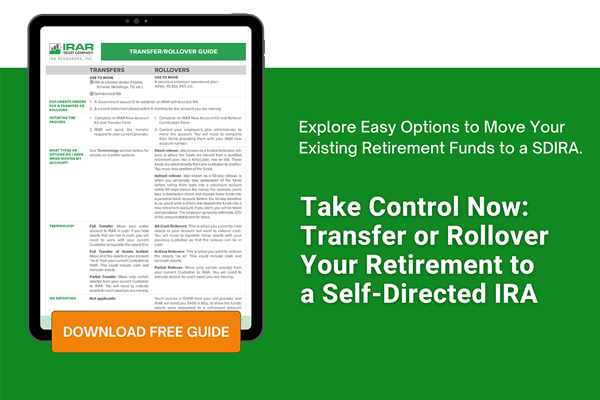How to Rollover Your Old 401k to Invest in Real Estate

If you have changed jobs or retired and have left savings in a former employer's retirement plan (e.g. 401(k), 403(b), governmental 457 (b)), you can move these funds to a self-directed IRA and invest in real estate without loss or penalty. Real estate investments in self-directed IRAs grow tax-deferred or tax-free until withdrawal. This means that when your property generates income or is sold, these profits are not taxed at the time because they go back to the IRA. It is not until you start taking distributions at retirement that the income will be taxed, depending on the type of plan you have.
It’s important to note that if you are currently employed and have a retirement savings plan (such as a 401(k) with your employer) this plan may not be transferable to a self-directed IRA. However, as long as the plan administrator allows, you can invest in almost everything imaginable (with the exception of collectibles and life insurance, see IRC 4975). Note that the investment must be for the benefit of your retirement plan and not for your personal benefit.
IRAR Trust is a self-directed IRA provider and has 21 years of experience with rollovers of 401(k) plans into self-directed IRAs to invest in real estate. Our clients invest in an extraordinary variety of different types of real estate: single family, commercial property, land, notes, mortgages, real estate investment trusts (REITs), and more.
Here is what you need to know to get your old 401(k) in a self-directed IRA and start investing:
Compare Self-Directed Custodians to Start Your 401(k) Rollover
You will need a self-directed IRA provider, like IRA Resources, to help you invest in real estate with your old or abandoned 401(k). While researching providers compare fees and services before opening an account. Do the research and reap the rewards of an excellent self-directed IRA provider— it makes a world of difference.
Open a Self-Directed IRA
Once you have identified your self-directed IRA provider, you will need to open an account. Determine what type of account is appropriate for you. You can move your 401(k) funds to a self-directed Traditional IRA, Roth IRA, SIMPLE IRA, or SEP IRA. There are special rules for the Roth IRA and SIMPLE IRA. If you are interested in any of these accounts, give us a call. Our Certified IRA Services Professionals (CISP) would be happy to talk to you.
Move the Funds from the 401(k) to the IRA
Most 401(k) plans can be “rolled over” by moving the current funds to a self-directed IRA. Here are your rollover options:
Direct Rollover:
Ask your plan administrator to make the payment directly to your self-directed IRA provider. Contact your plan administrator for instructions and forms to be completed. The administrator will issue a check payable to the new self-directed IRA provider for the benefit of (FBO) your account. In this case, no taxes will be withheld from your rollover amount. Here is an example of how the check will be payable: IRA Resources FBO John Doe, Account #123445.
You may also instruct your plan administrator to wire the funds into your new self-directed IRA. Your self-directed IRA Provider can provide you with instructions on how to wire the money. Keep in mind that your plan administrator might charge a fee for moving the funds and your self-directed IRA Provider for receiving the funds. In this case, the One Rollover-Per-Year Rule does not apply. See below.
60-Day Rollover or Indirect Rollover:
If the old 401(k) funds are paid directly to you, 20% in taxes will be withheld before you get the check. This is important to keep in mind when calculating how much you will have in your account for the real estate purchase. You must deposit these funds in your self-directed IRA within 60 days. If you do not meet this deadline, you will not be able to rollover the funds and the full amount will be taxable. In this case, the One Rollover-Per-Year Rule applies. (see below)
One-Rollover-Per-Year Rule:
You can make only one rollover from an IRA to another IRA in any 12-month period, no matter how many IRAs you own (as of 2015). As stated before, in the case of a direct rollover from a 401(k) plan administrator to a self-directed IRA provider, this does not apply.
Purchase the Real Estate Investment
Once your self-directed account is fully funded, you are ready to make the purchase. It is important to make sure that you move the funds to your IRA provider as soon as possible in case you need to put down an earnest money deposit on a property. The deposit, as well as the investment, must come from the self-directed IRA and not from personal funds if the intent is for the investment to be in a tax-deferred environment. To initiate this process, you will need to give your self-directed IRA Provider instructions for the purchase. At IRA Resources, we use a Buy Direction Letter for Real Estate.
We highly recommend that before you make your purchase or provide a deposit, you should explore your purchase strategy. Here are the most common strategies used by real estate investors.
Direct Purchase
Direct Purchase is when you purchase the asset using only money in your self-directed IRA. Your IRA pays all-cash for the investment. It is the simplest and quickest way to fund a purchase.
Partnering
Partnering is when you bring in other sources of cash to fund the purchase. You can partner with other people’s IRAs or with their personal funds. You can also partner your IRA with your own personal funds, but only during this initial transaction— otherwise this is a prohibited transaction. If you plan to self-partner, please discuss your plans with a representative to ensure your chosen strategy is allowed.
If partnering, after purchase you would then divide the investment profits and expenses among investors based on ownership percentage. For example, if a husband and wife partner on a piece of real estate (with the wife contributing 60% and the husband 40%), when paying expenses or receiving income from the property, both profits and expenses are split 60/40.
Non-Recourse Loan / Leveraging
Leveraging is when your IRA takes out a loan, typically known as a non-recourse loan. This sort of credit is common in real estate purchases and cannot be obtained by going through traditional means. We work with many non-recourse lenders.
LLC / Checkbook Control
LLC / Checkbook Control is the process of establishing a limited liability company (LLC) with IRA funds and using the LLC to buy the asset. The investment is then held in the name of the LLC. These are called Checkbook IRAs because you have direct access to your IRA funds via a checking account that is owned by your IRA. IRA Resources does not sell or create LLCs. To learn about how to form an LLC, visit the IRS website or your local SBA district office for more information.
How IRAR Can Help You Convert Your 401(k) to Invest in Real Estate
To learn more about rolling over funds from a 401(k) or go over these steps and strategies give us a call, 888-322-6534. We would be happy to answer any questions you may have about investing in real estate with your self-directed IRA.
401k Rollover FAQs
How do I transfer a 401k to an IRA?
To transfer a 401k to an IRA while still employed, the plan must allow the movement of the funds. Ask your plan administrator if this is allowed. If you are no longer employed, you can move your retirement plan by doing a rollover.
How long do I have to rollover a 401k to a self-directed IRA?
You have 60 days from the day you received the plan funds and/or assets. If you miss this deadline, the full account value becomes taxable.











Comments (2)